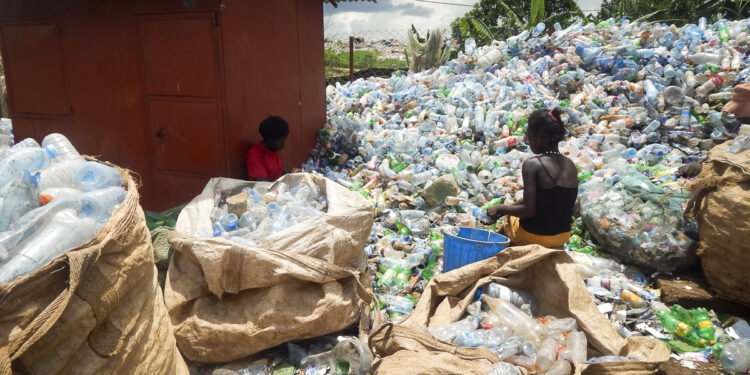Everyone, both the well-informed and less-informed is aware of the harm the plastic waste is doing to the environment. As it affects our personal health and the wellbeing of the earth no one can remain indifferent or unconcerned about this menacing plastic pollution which is unfortunately growing rather than reducing. We have seen it through the visualizing images of landfills or sea beaches that are covered with plastic bags, bottles, and other commonly made from plastic. The harmful effects of minute plastic fragments, such as microplastics (millimetre in size) and nanoplastics (micrometre in size), on marine creatures, terrestrial plants, birds, and human beings have become a much-discussed topic of the present day.
Due to unchecked production of plastic and its waste after short use will soon push us to call this age Plastic Age. Bearing this title is not a credit but a curse upon our age. The unchecked pollution is caused by plastic waste most of which come from packing materials and convenience materials of single use. Some objects such as coffee cups and straws are used only for a few minutes and when discarded remain in landfills, earth and ocean for many centuries. This explains our thoughtless living. Fortunately the world is becoming more and more aware of this adverse use of plastics and the imminent danger we are causing to the earth, which is our common home.
Let us remember the words of Dan Jacobson, an American environmental activist, “Nothing we use for a few minutes should be allowed to pollute our rivers and oceans for hundreds of years – especially items we don’t really need.” It is good to remind ourselves of the shocking information related to plastic and its use and abuse.
Unchecked Plastic Production:
Half of all plastics ever manufactured have been made in the last 15 years.
· Of all plastics the world has produced, only 9% of the nine billion tons has been recycled—most ends up in landfills, dumps, or in the environment, especially the oceans, it is expected to contain 1 ton of plastic for every 3 tons of fish by 2025 and, by 2050, more plastics than fish (by weight).
· Plastic manufactured in the first 10 years of this century eclipses the total produced in the entire last century.
· If the growth of plastic production continues at the current rate, the plastic industry could account for 20% of the world’s total oil consumption by 2050.
Nearly a million plastic bottles per minute are produced—about 480 million single-use plastic bottles in 2016.
Plastic production increased exponentially, from 2.3 million tons in 1950 to 448 million tons by 2015. Production is expected to double by 2050.
Pollution by Single Use Packaging Materials:
More than 1 million plastic bags are used every minute, with an average “working life” of only 15 minutes.
Half a million straws are used in the world every day.
· 500 billion plastic bags are used annually—and that’s just plastic bags, not to mention all other plastic items.
· The packaging sector is responsible for almost half of the plastic in the world.
Each minute 1,000,000 plastic bottles are purchased worldwide.
In the United States alone, we purchase 50 billion plastic bottles each year.
An estimated 4 trillion plastic bags are used worldwide each year.
Americans throw away 100 billion plastic bags each year, which equates to about 306 plastic bags per person.
· Styrofoam products, containing possible carcinogens such as benzene and styrene, are highly toxic when ingested and can damage animals’ lungs, nervous systems, and reproductive organs.
Pollution in Water bodies:
· Almost a third of all plastic packaging leaks out of collecting and sorting systems and ends up in soil and the ocean.
· Thirty-two percent of the plastics produced each year flow into our oceans. That equates to one garbage truck of plastic being poured into our oceans every minute.
· Many marine species, such as turtles and dolphins, mistake plastic fragments for food. Ingesting plastic is often fatal to animals—too much plastic blocks their digestive tracts, causing them to starve.
Plastic fragments have been found in 86% of all sea turtle species, 44% of all seabird species, and 43% of all marine mammal species.
· Marine mammals also become entangled in plastic debris, causing drowning and suffocation, or becoming easy prey for predators.
If nothing changes, it is estimated that by 2050 there will be more plastic in the ocean than fish.
Plastic debris, laced with chemicals and often ingested by marine animals, can injure or poison wildlife.
Floating plastic waste, which can survive for thousands of years in water, serves as mini transportation devices for invasive species, disrupting habitats.
· Every year, about 8 million tons of plastic waste escapes into the oceans from coastal nations.
· Studies suggest that the total economic damage to the world’s marine ecosystem caused by plastic amounts to at least US $13 billion every year.
Plastics Becoming Health Hazard:
· Chemicals ingested by the animals and seafood can make their way up the food chain onto our dinner plates.
Chemicals added to plastics are absorbed by human bodies. Some of these compounds have been found to alter hormones or have other potential human health effects.
Plastic buried deep in landfills can leach harmful chemicals that spread into groundwater.
Plastic takes years to break down. The Marine Conservancy estimates that it takes 450 years to break down a plastic bottle and 400 years to break down disposable diapers.
In caring for the environment we need to think global and feel one as citizens of one earth, our common home. The pollution we cause affects everyone and the good we do benefits everyone. If we fail to care for Uganda which is a pearl, soon we will poison our lakes, rivers, forests, national parks and turn our fertile soil into deserts. The great suffering that might fall on us which we cannot bear.
Fr. Lazar Arasu SDB
Priest and Educationist
Do you have a story in your community or an opinion to share with us: Email us at editorial@watchdoguganda.com













